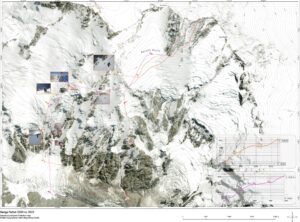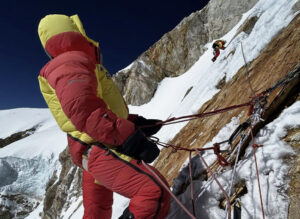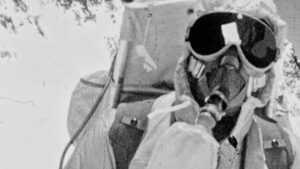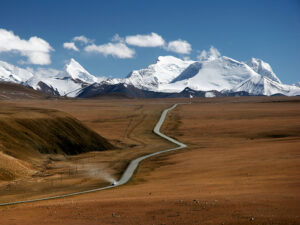David Goettler is on his way to Nanga Parbat with French skiers Tiphaine Duperier and Boris Langenstein. The 43-year-old German is tackling Nanga Parbat for the third spring-summer in a row and his fifth time overall. This week, he spoke to ExplorersWeb about his plans and the changing world of Himalayan climbing.
Last year, Goettler teamed up with Mike Arnold of the U.S., but Arnold decided to abort his attempt. Goettler spontaneously joined with Duperier and Langenstein, who were attempting to ski the mighty Rupal Face. The three launched a single, alpine-style push but didn’t succeed.

David Goettler on a previous expedition. Photo: Herve Barmasse
Twelve months later, Goettler, Duperier, and Langenstein are back to attempt the hardest side of the mountain again. Duperier and Langenstein are world-class alpinists and skiers who are familiar with Nanga Parbat. In 2019, Duperier reached 7,800m while Langenstein summited. He then started skiing down from 50m below the top, the first point at which skiing was possible.
Duperier joined him at 7,800m as he descended, and they skied down the rest of the way together. The pair also skied Laila Peak in 2018 and Gasherbrum II’s South Spur in 2021.
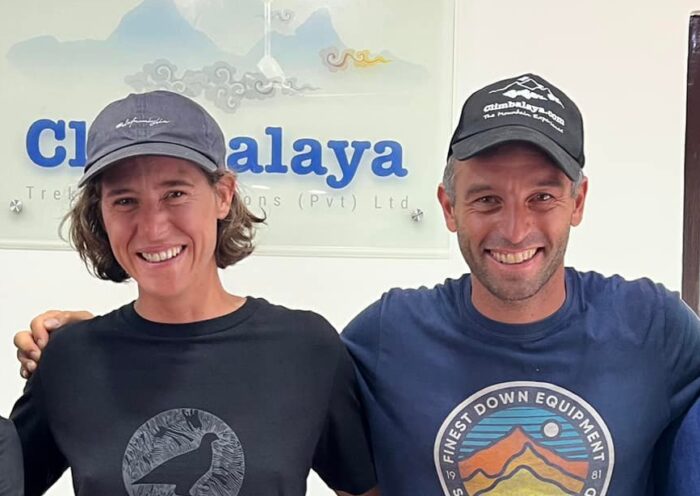
File image of Tiphaine Duperier and Boris Langenstein in 2022. Photo: Climbalaya
Baruntse
The three climbers began their preparations in late spring in Nepal, climbing in Langtang, then on Island Peak. Their prep culminated last week with an after-season ascent of Baruntse in the Khumbu.
“We were just days after the Everest climbers had finished, and the Khumbu was completely empty,” said Goettler. “We had such a good time. Climbers complain about the crowding but then insist on climbing only in April and May. We need to spread out the season differently.”
Goettler also praised winter as an interesting time to climb lesser peaks in Nepal. “Trekking peaks can be climbed all winter long with good equipment,” he said. “During the day, it’s often sunny and nice, and you’ll have the mountains to yourself.”
On Baruntse, they indeed had the peak to themselves, and in fact, theirs were the only summits this year. Conditions were good in base camp, but as the trio set off toward the top from their high camp at 6,400m, they were enveloped in a whiteout. They had to use their GPS devices to ascertain the highest point on the ridge.
The thick fog also thwarted Duperier and Langenstein’s plan to ski down, while Goettler had hoped to paraglide down to Base Camp the fast way. On the positive side, the wind was not too strong, unlike most of this climbing season.
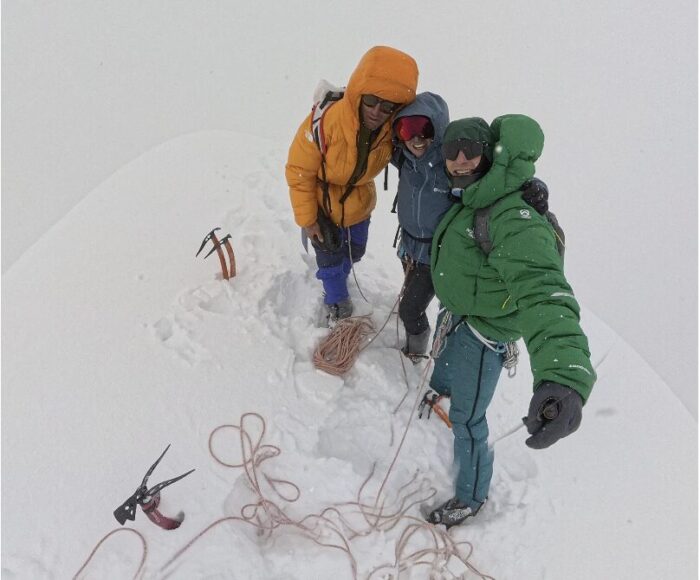
Langstein, Duperier and Goettler on the summit of Baruntse. Photo: David Goettler
Changing conditions
The German noted how the mountain is becoming harder to climb because of climate change.
“The ice is getting more and more tricky, there are two big crevasses that are opening up and getting more difficult to navigate around,” he said.
He explained that at a certain point, they had to rappel down and then climb up the other side of a crevasse. They had a 60m rope with them, but commercial teams would need to install ladders across it.
“The conditions on 6,000’ers and 7,000’ers are changing fast because of global warming,” said Goettler. “Island Peak, for instance, is now bare of ice on the upper sections, and rockfall is frequent. It can still be done, but climbers need to know that in advance and not underestimate the climb.”
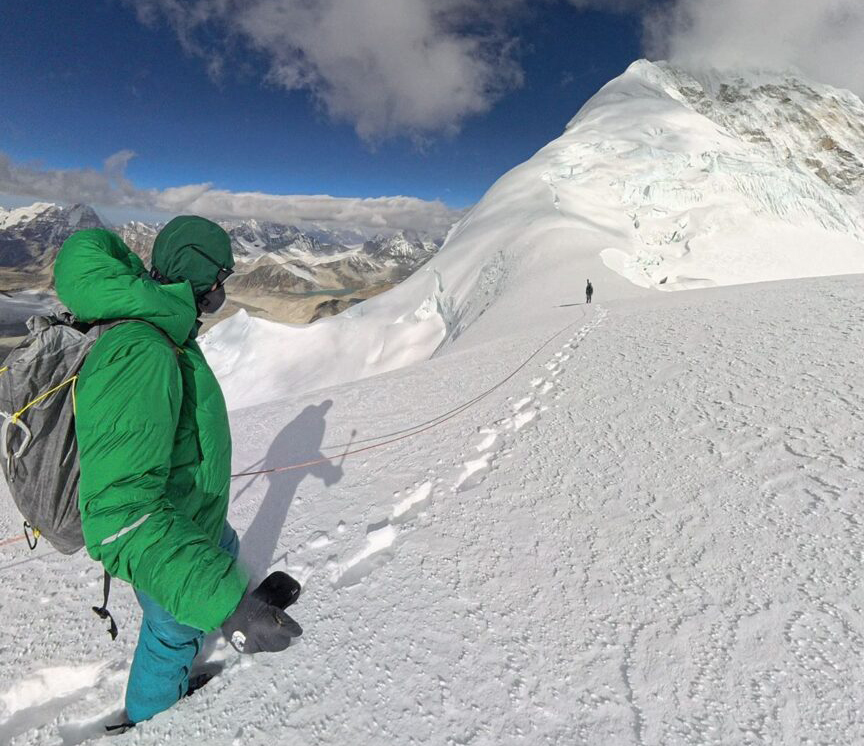
The clouds briefly clear on Baruntse. Photo: David Goettler
Different times
David Goettler visited Nepal for the first time in 2003 and has returned at least once a year ever since. He has seen both the country and the climbing scene change during that time.

David Goettler and Gerlinde Kaltenbrunner on Dhaulagiri in 2008. Photo: Bergsteigen.com
Goettler climbed with some of the best-known high-altitude climbers of the early 21st century, from Gerlinde Kaltenbrunner and Ralf Dujmovits to Ueli Steck and Simone Moro. He has seen the evolution from small teams to the crowds on Everest. And yet, he climbed Everest without oxygen or Sherpa support in 2022.
“The commercial side of the 8,000’ers has exploded in the last decade, but this is a development that we saw in the Alps years ago and now we see in the Himalaya,” he said.
Oxygen is not alpinism
“The issue is that we — meaning both wide audiences and seasoned climbers — still confuse the concepts of alpinism and commercial ascents. They are completely separate activities.”

Cooking dinner on Nanga Parbat in winter. Photo: Herve Barmasse
Goettler adds:
I have no problem with people climbing Everest in five days with all the help they can get, but their motivations to climb that mountain are totally different from mine. What these express teams are doing cannot be considered an evolution of alpinism but an evolution of a touristic activity that takes place in the mountains.
They have a right to be there, as long as they respect the environment, the local communities, and the safety criteria. People also climb Mont Blanc in the Alps [with a boost from] cable cars, which are even more invasive than helicopters. In some aspects, we should learn from the mistakes we made at home.
The German climber has a similar view about the Xenon therapy used by the British team that climbed Everest in five days.
“For me, Xenon wouldn’t be an option because I consider it an external aid, like oxygen, and I do not use oxygen when I climb at altitude. However, there is no big difference between using Xenon and using oxygen, which can be set to flow at up to eight liters per minute,” said Goettler. “I don’t understand why some are outraged about Xenon but consider using oxygen the most natural thing.”
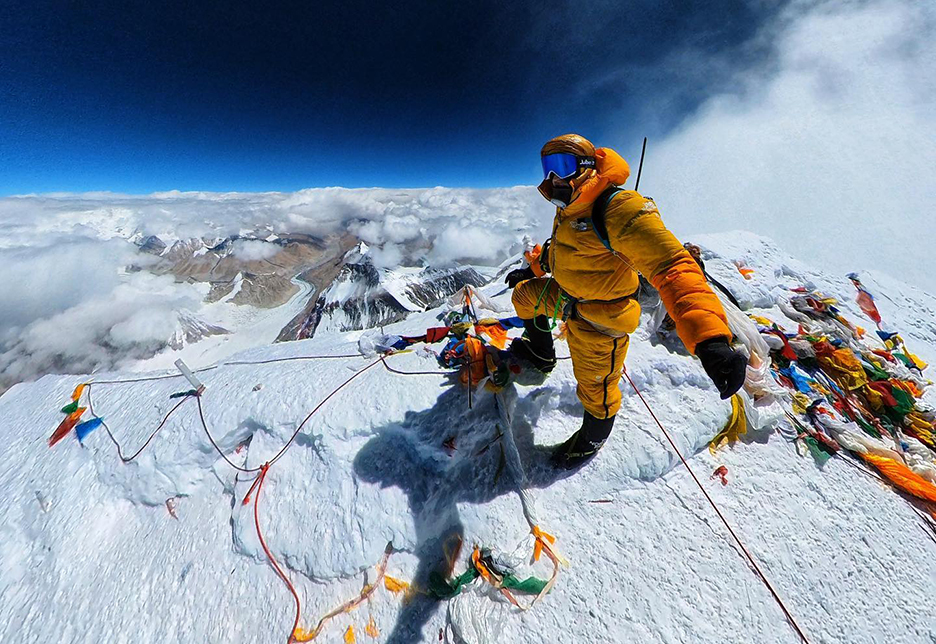
David Goettler on the summit of Everest. Photo: Facebook
Longing for freedom
In recent times, alpine-style teams seem to focus on lonely peaks less than 8,000m high but which offer isolated locations and options for new routes. Meanwhile, on the 8,000’ers, almost everyone sticks to the normal route. Can guided teams and alpinists coexist on these highest peaks?
Goettler believes they can, but he is concerned about an excess of regulations, such as the ones in Nepal that begin this fall, which practically ban independent climbers.
The concern is we might end up with hyper-regulated expeditions as in Tibet, when you can’t just obtain a permit to climb anywhere beyond the normal route or to climb Everest without oxygen. I wish so much to go to Cho Oyu, where there are options to climb new routes from Tibet, or Shisha Pangma, where I retreated some meters below the summit on the South Face! I hope Nepal will not go the same way.
I am happy I had the chance to experience the Himalaya when there were not so many regulations and not so many people.

Goettler and Herve Barmasse during a previous expedition. Photo: Herve Barmasse
Goettler also believes that there is potential for new routes on the 8,000’ers, but that sometimes, bureaucracy stands in the way. “As I said, Cho Oyu offers options, but getting a permit now would be much more difficult than the climb itself.”
He adds that other 8,000’ers still offer “some crazy-difficult faces that I would never attempt.”
The risk debate
In this modern era, Himalayan alpinists are not unanimously admired for their purity of spirit. They sometimes receive criticism for the risk their activity involves. Guide and outfitter Lukas Furtenbach recently compared alpinists to modern gladiators ready to die, and who “eschew safety margins and embrace high personal risk.”
Responds Goettler, a professional mountain guide who has climbed since he was seven years old: “I assure you, I consider what I do very far from suicidal, especially if you bear in mind the huge number of times I have turned around on expeditions. Of course, commercial expeditions must prioritize safety, which is exactly what I do when I am guiding clients, but also when I climb on my own. My own climbing projects might look risky from the outside, but I am very conscious of conditions during every moment of the climb, the equipment I use, my skills, and how to keep within acceptable margins of safety.”

Goettler, left, and Herve Barmasse on winter Nanga Parbat. Photo: Herve Barmasse
Goettler says he has acquired experience and skills in small steps over the years.
“This may not be the norm now, when fewer people are ready to invest time to learn and evolve as climbers,” he says. “Instead, they take shortcuts to the summit, by taking oxygen, a guide, etc. Again, I don’t judge such choices, and it works for some people, who climb the 14×8,000’ers during their first two years in the mountains. But that does not mean they are capable of making any decision on their own up there. That only comes through knowledge and experience.”
Climb up, fly down
Goettler tries to paraglide from his summits. He points out that while ascents are regulated, flights in Nepal are allowed on nearly every mountain. This makes it possible to avoid dangerous descents and even makes new routes safer.
“If conditions permit, flying down from the summit is the safest way I can think of descending a mountain,” he said.
Paragliding from summits after fast and light climbs has become a trend among elite climbers, especially in Europe. Last year, Benjamin Vedrines sped up K2, then paraglided down from the summit, doing the round trip in 11 hours. Others on his team also flew from the top that day.
Back to Nanga Parbat
Goettler considers Nanga Parbat a special peak, quite different from Everest on the 8,000m spectrum.
This will be Goettler’s fifth attempt on Nanga Parbat via the Schell route on the sheer Rupal Face. He has tried twice in winter, first in 2013-14 and then in 2021-22 with Herve Barmasse and Mike Arnold. He attempted it again with Benjamin Vedrines in 2023 and with Mike Arnold last year.
In addition to being one of the biggest mountain faces in the world (it’s nearly 4,600m from base to summit), the Rupal Face of Nanga Parbat can be especially dangerous in mild temperatures. That is one of the reasons Goettler attempted it in winter. However, he believes conditions may remain good for a few more weeks.
“The route is risky in summer since a lot of rocks are falling on the lower part, but the last two years, I went there in June, and conditions were okay.”
Their plan is to climb the mountain alpine style. If all goes well, he will fly back down to Base Camp, although he admits that the chances for that will be “very slim.” His partners will ski.
Goettler, Duperier, and Langenstein move to Nanga Parbat this week, and we may not hear from them in a while. We will update when we do.


